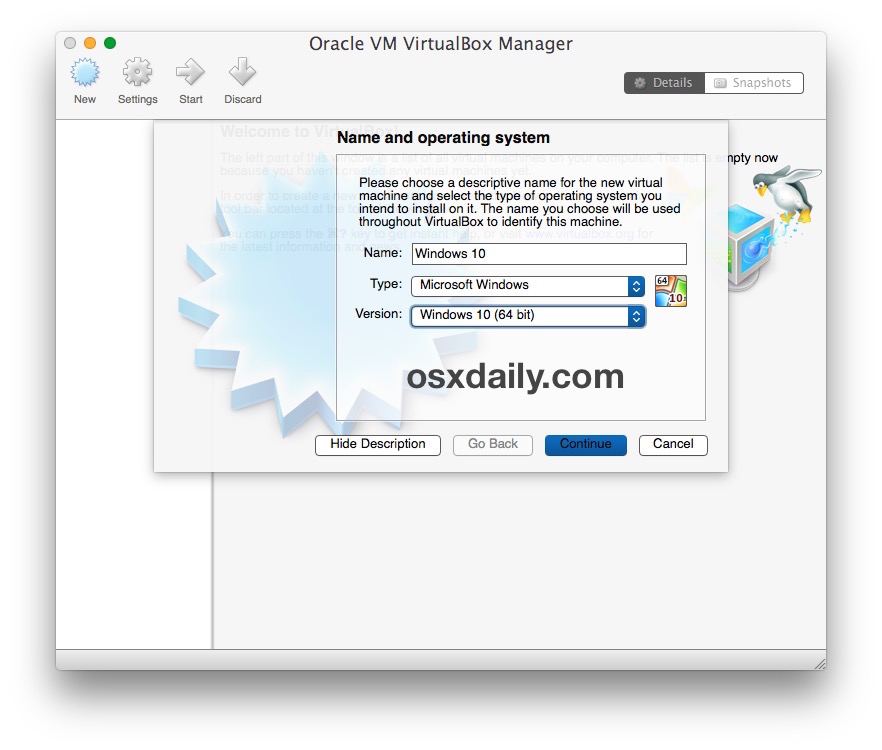Windows Virtual Machine For Mac
The cost of software. You can pay for virtualization software or find a free alternative, but Windows itself isn't free. And if your can't-live-without it Windows app is Microsoft Office or an accounting program or a point-of-sale system, well, you have to pay for that too.
Create Virtual Machine on Mac. To create virtual machine on Mac, open the VirtualBox first, then tap on the “New“.Once you clicked on “New”, a small window will pop up.

I have a handful of Windows programs that don't have Mac alternatives, and I have. So if a virtual machine can handle both Windows and OS X apps gracefully, I would have a much easier time moving back and forth.
It majorly performs hardware virtualization. QEMU is flexible to work with because guest operating systems don’t require patching to run inside it. A very different feature of this virtual machine is that it stores virtual disk images in a special format (qcow or qcow2). This only takes up the disk space in the guest operating system. It also has a VNC server that allows the user to access the screen of the guest Operating system. The virtual hardware support is limited but supports a wide range of processors including ARM, MIPS and other (Virtual Box support ). VMware fusion Platforms: MAC OS X Key features: Upto 5k iMAC monitor support natively (MAC) VMware fusion was developed by VMware Inc.
Despite the Mac's recent gains in market share, Windows is still the dominant operating system, especially in businesses. That means there may be times when you need to run the Microsoft OS: perhaps there’s an application your company uses that’s only available for Windows, or you’re a web developer and you need to test your sites in a true native Windows web browser. Or maybe you want to play computer games that aren’t available for OS X. Whatever your reason for running Windows, there are a number of ways your Mac can do it for you. If you need to run just one or two specific Windows apps, you may be able to do so using ( ), which can run such applications without requiring you to actually install Windows. (CrossOver's vendor, CodeWeavers, maintains a.) If you need a more flexible, full-fledged Windows installation, you still have several other options. You could use Apple’s own, which lets you install Windows on a separate partition of your hard drive.
I haven't seen any notes on this topic, but I thought a brief comment might be useful. I'm running Windows 7 as a virtual machine under OSX 10.5.6 on a MacBook Pro. I've never had any problems with Vista (Office Pro) and I haven't really had any problems with Windows 7 on the Mac. My network connection is going through the Mac system, but seems to work as fast as my browsers work under 10.5 on the Mac.
It keeps calling for a security system to be added, but Defender is part of the program as is IE 8. I am using Win XP as the host machine. In the initial setup I had to choose Vista, Just for the size allocations for memory and HD. Started out with mem. Optimize pdf for mac. Set to the max at 700, then dropped back to 600, better access now. HD is set to 64 G.
In the past, I tried to answer that question by, to see how they did on specific tasks. This time, however, that task-based approach didn’t work, largely because (with a couple exceptions that are noted below) the latest versions of Fusion and Parallels Desktop are nearly indistinguishable in performance. So instead of picking one program over the other based on how well it performs a given task, the choice now hinges on some more subjective factors. So this time around, I’ll look at those and try to explain how the two programs differ on each.
Basically, this hypervisor enables both the virtual machines to work with their processors, their RAM, their Floppy drive and hard disk, as a physical computer contains. Unlike Hyper-V, it provides pass-through drivers for the parallel port and USB devices. VMware vs Parallels! Difference is subtle QEMU Platforms: Linux, MAC, Windows Key features: 32-bit and 64-bit installer, Control via command line. QEMU stands for Quick Emulator.
Runs guest macOS virtual machines. Can use the same virtual machines created on VMware products running in Windows and Linux. Can be used to run nearly any intel-hardware OS. Cons: Slower and less beginner-friendly than Parallels Desktop. Microsoft skype for business mac. Virtual machines not as tightly integrated with macOS as Parallels Desktop's. Bottom Line: VMware Fusion 8.5 is a top corporate-level choice for virtual machines on Macs.